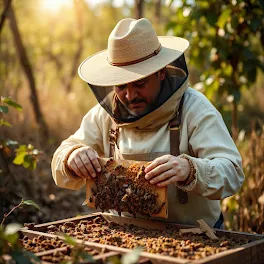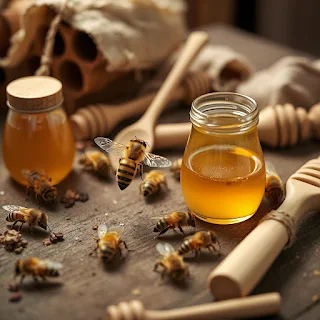Bee Farming, Bee Keeping, Apiculture, Honey bee, Raising Bees, Managment, and Profitability.
Bee Farming
The practice of raising bees and the managment of honeybee colonies in artificial hives for commercial purposes like honey production, beeswax, royal jelly, propolis, bee pollen, and crop pollination is referred to as "Bee Farming," and it is also known as "Apiculture." Bee Farming is a popular option for modern agriculture and homesteading due to its low investment, eco-friendly nature, and high returns.
Types of Bee Farming
1. Raising Bees, Traditional Way:
- Makes use of local materials like wooden logs and clay pots. No advanced equipment or inspection tools while Raising Bees.
- Low honey yield, suitable for subsistence use.
2. Bee Farming, Modern/Scientific Way:
- Utilizes "Langstroth hives" or "Top-bar hives".
- Enables easier honey extraction and colony inspection.
- Higher honey production, better disease control.
Popular Honeybee Species Used in Apiculture
| Bee Species | Common Name | Characteristics |
|---|---|---|
| Apis mellifera | Western Honey Bee | Most common species used in commercial beekeeping; very productive |
| Apis cerana | Asiatic Honey Bee | Native to Asia; resistant to local diseases and climate conditions |
| Apis dorsata | Giant Honey Bee | Wild and aggressive; not suitable for domesticated farming |
| Apis florea | Dwarf Honey Bee | Small size; builds open nests in bushes and trees |
| Trigona | Stingless Bee | Does not sting; produces small quantity of medicinal honey |
Bee Farming Best Management Practices:
1. Location:
The Location selection for Bee Farming should be rich in flowering plants (minimum 3 seasons of bloom).
Free from pesticide drift and industrial pollution.
Good water source and shade.
2. Hive Management Techniques:
- Use movable-frame hives (Langstroth recommended).
- Space hives 2–3 feet apart.
- Regular checks for diseases and pests.
3. Seasonal Beekeeping Tasks:
- Spring: Peak nectar flow, maximize honey collection.
- Summer: Provide water, manage overheating.
- Rainy Season: Check for mold or a disease and prevent flooding.
- Winter: Insulate hives, feed sugar syrup.
4. Control of Swarming and Reproduction:
- Prevent crowding.
- Divide colonies as needed.
5. Feeding and Adding to the Diet:
- Sugar syrup (1:1) during the driest months.
- Pollen patties for protein support.
6. Control of diseases and pests:
- Common pests: Varroa mites, wax moths, ants.
- Infections with fungi and bacteria include Nosema and American foulbrood.
- Practice good hygiene and use prescribed treatments in moderation.
Essential Beekeeping Products:
| Product | Use Case |
| Honey | Honey is a natural sweetener with medicinal uses. |
| Beeswax | Candles, cosmetics, pharmaceuticals |
| Royal Jelly | Supplements for the diet and skincare products |
| Propolis | is a natural antibiotic and preservation agent. |
| Bee Pollen | Nutritional and energy supplement. |
| Pollination Services | Enhances crop yield and quality. |
Profitability of Bee Farming (in USD):
1. Initial Setup Costs
- Bee Hives: $35–$60 per hive.
-Bee Colonies: $25–$45 per colony.
-Starter Kit (10 Hives): $800–\$1,200 (including tools, suit, smoker, extractor).
2. Annual Operating Expenses:
Feeding, maintenance, disease control: $15–\$20 per hive/year.
3. Revenue and Honey Yield:
Average honey per hive: 22–44 lbs (10–20 kg) annually.
Market price of raw honey: $5–\$12 per lb.
- Depending on the market, bee species, and floral availability, annual income per hive ranges from $100 to $500.
4. ROI (return on investment):
- Breakeven in between one and two years.
- Net profit margin: 30%–60%, with potential to scale up.
Benefits of Bee Farming
-Low capital requirement.
-High market demand for natural honey and bee products.
-Boosts agricultural productivity via pollination.
- Ideal for rural livelihoods and small landholders.
- scalable and sustainable in terms of the environment.
Common Challenges in Apiculture
- The loss of bee colonies as a result of pesticides and climate change.
- Predator attacks and disease outbreaks
-Poor access to quality "queen bees" and modern equipment.
- Obstacles to marketing include price fluctuations and adulterated honey.
-There is a lack of instruction in scientific beekeeping.
Strategies for Commercial Bee Farming Success
1. Take certified beekeeping training from agricultural universities or government programs.
2. Use "Langstroth hives" for best honey yield.
3. Join local beekeeping cooperatives or farmer-producer organizations.
4. Explore "organic certification" and value-added products.
5. Use "digital marketing" and "eCommerce platforms" to sell honey directly.
Resolution
Bee farming is an agribusiness that makes money and is important to the economy and the environment. Through pollination, "apiculture can provide sustainable income" and "can enhance biodiversity" with appropriate training, modern hive management, and access to markets.


























0 Comments